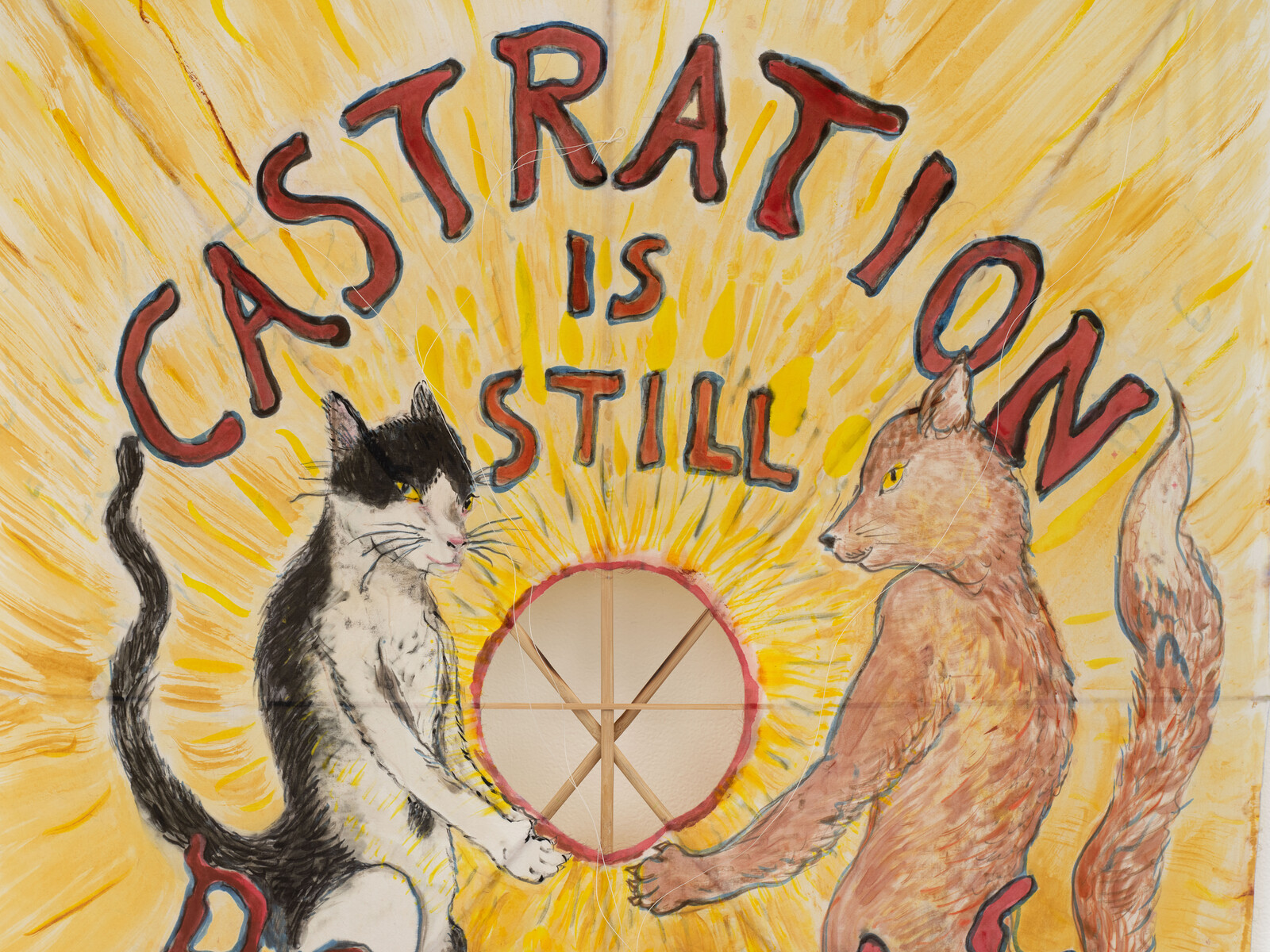Talbot Rice Residents
March 16–June 1, 2024
Old College
University of Edinburgh
Edinburgh EH8 9YL
UK
Hours: Tuesday–Saturday 10am–5pm
T +44 131 650 2210
info.talbotrice@ed.ac.uk
Talbot Rice Gallery announces two exhibitions to open on March 16, 2024: Candice Lin: The Animal Husband and Talbot Rice Residents: Alaya Ang, Crystal Bennes, Renèe Helèna Browne, Ross Fleming, Maria de Lima, Sekai Machache, Emmie McLuskey, Thulani Rachia, Kirsty Russell, Matt Zurowski.
In her first solo exhibition in Scotland, Candice Lin brings together new and existing work to play with the University of Edinburgh’s former Natural History Museum as a site of corrupted encounters, transgressions and transformations. Queering human and animal relationships, Lin uses a vocabulary of crude, ambiguous and dreamlike imagery to expose the conceits surrounding the scientific categorisation and control of bodies, and its links to the construction of race, gender, animality and humanness.
The ceramic sculpture Piss Protection Demon will greet visitors with the smell of wolf urine, what merchants describe as “territorial deception scent” used to ward off so-called pest-animals or provoke the curiosity of other predators. Examining narratives of dominance, wildness and masculinity, its cat body, human ears and an inverted wolf skull speak of possible metamorphoses, trans-species projections and desires. In the centre of the gallery, a kinetic screen showcases a new video featuring an animated version of the artist’s cat, Roger, who philosophically ruminates on his relationship to Lin, the flesh lump that lives with him. He alludes to Thomas Granger, the first juvenile executed in the Plymouth Colony, during the early colonization of America. Roger narrates how Granger was given a death penalty for sex with animals and talks vividly about his own experience of castration, the draining of his ball juice being—as he puts it—and an “inevitable trading of power.” This links to Lin’s interest in Howard Chiang’s study of eunuchs, where Western sexologists condemned what English soldier George Carter Stent (1833– 1884) called in his influential but questionable account, the “unnatural proceedings” of castration. A cicatrix, the scar left after the removal of the penis, becomes a motif throughout the space: a symbol reappropriated from Western medical sources which sensationalized the practice as emasculating and debasing
A new series of intimate pewter sculptures hang from metal human-sized collars, suggesting non-normative reversals in the relationship between companion animals and their owners. The cast metal is surfaced on one side with a fleshy wax substance inscribed with wound-like images of feeding, embracing and more than friendly human and animal exchanges. Lin’s earlier work The Moon/Inside Out (2010) directly addresses William Hunter’s famous anatomical study of the Gravid Uterus, based on his dissections of pregnant women. Lin’s ceramic and mixed media sculpture implicates the viewer and the anatomical mode of observation in uncomfortable questions around intimacy and consent. Looking through the vagina to watch an animation, you are implicated within a self-reflective peep show that also references voyeuristic elements from the canon of male-centred Western art.
The Animal Husband proffers perspectives that exist outside the realm of essentialising discussions about what human and non-human animals are. It offers an imaginative treatment of a range of troubling, dark and critical subjects that arise when different species of being are produced and perceived.
In the adjoining gallery, the Talbot Rice Residents exhibition will foreground the practices of ten emerging Scottish-based artists, surveying some of the key concerns confronted by contemporary creative practice. This includes works that examine relations between colonisation and damaged indigenous cultures—pertaining to land rights, ecological systems and the power of dreams; the politics of movement; systems of care; the world of commodities trading and explorations of queer relationships and histories. The second exhibition by Talbot Rice Residents, it will feature artists from the final two cohorts of the programme. Supported by the Freelands Artist Programme, an incredible nationwide project that has supported 80 artists across the UK, propelling them to new heights.
Candice Lin’s exhibition is supported by Creative Scotland, Edinburgh College of Art and the Confucius Institute for Scotland. Talbot Rice Residents exhibition is supported by Edinburgh College of Art and Freelands Foundation.
Forthcoming at Talbot Rice Gallery
El Anatsui
June 29–September 29, 2024
We are delighted to announce a major exhibition of El Anatsui that will journey through a large selection of his iconic sculptural wall hangings, as well as a newly produced monumental work for Talbot Rice Gallery’s large gallery space. The exhibition will include carved wooden reliefs and printed works on paper and tell the story of the production of his monumental metal bottle-top artworks. Culminating in a huge outdoor installation on the façade of Talbot Rice Gallery, within the University of Edinburgh’s Old College Quad, the exhibition will be the most significant exploration of El Anatsui’s practice, which spans more than five decades, ever staged in the UK.
Stay in touch with us as we explore what the 16th-century University of Edinburgh, together with Edinburgh College of Art, can contribute to contemporary art research and production today and in the future.
Press contact: Melissa MacRobert melissa.macrobert [at] ed.ac.uk

